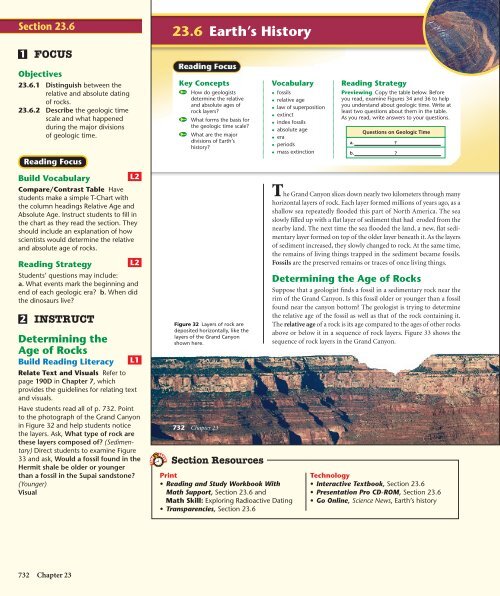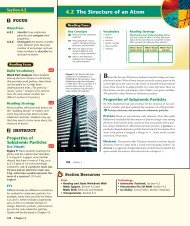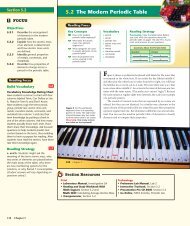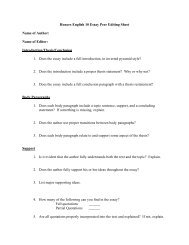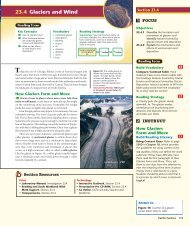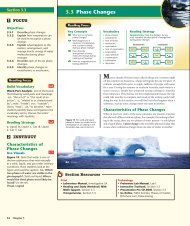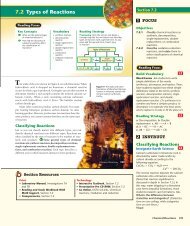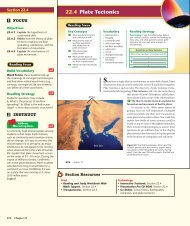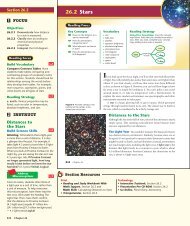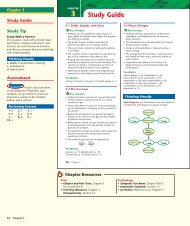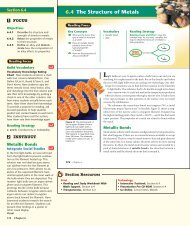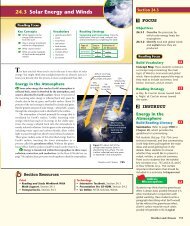23.6 Earth's History
23.6 Earth's History
23.6 Earth's History
Create successful ePaper yourself
Turn your PDF publications into a flip-book with our unique Google optimized e-Paper software.
Section <strong>23.6</strong><br />
1<br />
FOCUS<br />
Objectives<br />
<strong>23.6</strong>.1 Distinguish between the<br />
relative and absolute dating<br />
of rocks.<br />
<strong>23.6</strong>.2 Describe the geologic time<br />
scale and what happened<br />
during the major divisions<br />
of geologic time.<br />
Build Vocabulary<br />
Compare/Contrast Table Have<br />
students make a simple T-Chart with<br />
the column headings Relative Age and<br />
Absolute Age. Instruct students to fill in<br />
the chart as they read the section. They<br />
should include an explanation of how<br />
scientists would determine the relative<br />
and absolute age of rocks.<br />
Reading Strategy<br />
Students’ questions may include:<br />
a. What events mark the beginning and<br />
end of each geologic era? b. When did<br />
the dinosaurs live?<br />
2<br />
Reading Focus<br />
INSTRUCT<br />
Determining the<br />
Age of Rocks<br />
Build Reading Literacy<br />
732 Chapter 23<br />
L2<br />
L2<br />
L1<br />
Relate Text and Visuals Refer to<br />
page 190D in Chapter 7, which<br />
provides the guidelines for relating text<br />
and visuals.<br />
Have students read all of p. 732. Point<br />
to the photograph of the Grand Canyon<br />
in Figure 32 and help students notice<br />
the layers. Ask, What type of rock are<br />
these layers composed of? (Sedimentary)<br />
Direct students to examine Figure<br />
33 and ask, Would a fossil found in the<br />
Hermit shale be older or younger<br />
than a fossil in the Supai sandstone?<br />
(Younger)<br />
Visual<br />
<strong>23.6</strong> Earth’s <strong>History</strong><br />
Key Concepts<br />
How do geologists<br />
determine the relative<br />
and absolute ages of<br />
rock layers?<br />
What forms the basis for<br />
the geologic time scale?<br />
What are the major<br />
divisions of Earth’s<br />
history?<br />
Figure 32 Layers of rock are<br />
deposited horizontally, like the<br />
layers of the Grand Canyon<br />
shown here.<br />
732 Chapter 23<br />
Section Resources<br />
Vocabulary<br />
◆ fossils<br />
◆ relative age<br />
Print<br />
• Reading and Study Workbook With<br />
Math Support, Section <strong>23.6</strong> and<br />
Math Skill: Exploring Radioactive Dating<br />
• Transparencies, Section <strong>23.6</strong><br />
◆ law of superposition<br />
◆ extinct<br />
◆ index fossils<br />
◆ absolute age<br />
◆ era<br />
◆ periods<br />
◆ mass extinction<br />
Reading Strategy<br />
Previewing Copy the table below. Before<br />
you read, examine Figures 34 and 36 to help<br />
you understand about geologic time. Write at<br />
least two questions about them in the table.<br />
As you read, write answers to your questions.<br />
Questions on Geologic Time<br />
a. ?<br />
b. ?<br />
The Grand Canyon slices down nearly two kilometers through many<br />
horizontal layers of rock. Each layer formed millions of years ago, as a<br />
shallow sea repeatedly flooded this part of North America. The sea<br />
slowly filled up with a flat layer of sediment that had eroded from the<br />
nearby land. The next time the sea flooded the land, a new, flat sedimentary<br />
layer formed on top of the older layer beneath it. As the layers<br />
of sediment increased, they slowly changed to rock. At the same time,<br />
the remains of living things trapped in the sediment became fossils.<br />
Fossils are the preserved remains or traces of once living things.<br />
Determining the Age of Rocks<br />
Suppose that a geologist finds a fossil in a sedimentary rock near the<br />
rim of the Grand Canyon. Is this fossil older or younger than a fossil<br />
found near the canyon bottom? The geologist is trying to determine<br />
the relative age of the fossil as well as that of the rock containing it.<br />
The relative age of a rock is its age compared to the ages of other rocks<br />
above or below it in a sequence of rock layers. Figure 33 shows the<br />
sequence of rock layers in the Grand Canyon.<br />
Technology<br />
• Interactive Textbook, Section <strong>23.6</strong><br />
• Presentation Pro CD-ROM, Section <strong>23.6</strong><br />
• Go Online, Science News, Earth’s history
Kaibab-Toroweap limestone<br />
Coconino sandstone<br />
Hermit shale<br />
Supai sandstone<br />
Redwall limestone<br />
Muav limestone<br />
Bright Angel shale<br />
Tapeats sandstone<br />
Vishnu schist<br />
Younger<br />
Older<br />
The Law of Superposition Sedimentary rocks form as horizontal<br />
layers. Geologists have used this fact to establish a principle for<br />
determining the relative ages of rocks. The law of superposition states<br />
that if rock layers are undisturbed, younger rocks lie above older rocks,<br />
and the oldest rocks are at the bottom. Geologists use the law of<br />
superposition to determine the relative ages of sedimentary rocks<br />
from the sequence of rock layers and the fossils within each layer.<br />
Rock layers often extend over large regions. Geologists have examined<br />
sedimentary rocks from locations around the world to develop a relative<br />
time scale for many rock layers.<br />
Index Fossils and Relative Dating Geologists can also determine<br />
the relative ages of sedimentary rocks by examining the fossils that<br />
are found in them. Most types of organisms preserved as fossils are now<br />
extinct. An extinct type of organism is one that no longer exists.<br />
Fossils of organisms that are easily identified, occurred over a large<br />
area, and lived during a well-defined period of time are called index fossils.<br />
With index fossils, geologists can determine the relative ages of rocks. If<br />
a rock contains examples of an index fossil, then the rock must have<br />
formed during the time that that organism lived.<br />
Customize for Inclusion Students<br />
Gifted<br />
The topic of geologic history offers ample<br />
opportunities for extended studies. Interested<br />
students can research any of the geologic eras<br />
or periods in more detail. Some students may<br />
have interest in fossils or prehistoric organisms.<br />
Colorado River<br />
Figure 33 The walls of the Grand<br />
Canyon consist of many different<br />
layers of rock.<br />
Interpreting Diagrams Which<br />
of the sedimentary layers shown<br />
here is older, the Bright Angel<br />
shale or the Tapeats sandstone?<br />
Explain your answer.<br />
Earth’s Surface 733<br />
Have students contact the geology or<br />
paleontology department in your local<br />
community or state college, the regional<br />
USGS office, or a local science museum for<br />
information on fossils in your area. Ask students<br />
to present their research to the class.<br />
Build Science Skills<br />
L2<br />
Inferring Tell students that they can<br />
learn a lot about the geologic history of<br />
a region just by looking at rocks and<br />
landforms. Instruct students to study<br />
Figures 32 and 33. Then, using what<br />
they know about how different types of<br />
rocks and geologic features are formed,<br />
have them work in groups to create a<br />
relative timeline describing the evolution<br />
of the Grand Canyon. (Based on what<br />
they have learned in Chapters 22 and 23,<br />
students should be able to determine that<br />
the layers were deposited in a shallow sea<br />
environment. Limestone layers were<br />
created by the shells of marine organisms,<br />
while the shale and sandstone were<br />
deposited when sediment was eroded from<br />
nearby landscapes. Students should infer<br />
the order in which the rock layers were<br />
formed. Tectonic uplift or a lowering of the<br />
sea level caused the shallow sea to drain.<br />
Then, the Colorado River and its tributaries<br />
eroded the rock layers, exposing<br />
them to additional erosion by wind.)<br />
Logical, Portfolio<br />
Answer to . . .<br />
Figure 33 The Tapeats sandstone;<br />
according to the law of superposition,<br />
in a sequence of undisturbed sedimentary<br />
rock layers, older layers lie below<br />
younger layers.<br />
Earth’s Surface 733
Section <strong>23.6</strong> (continued)<br />
Interpreting<br />
Rock Layers<br />
Answers<br />
1. B; J<br />
2. Younger, since E and J are the same<br />
age and F lies atop E<br />
3. Layer D must be more than 430<br />
million years old.<br />
4. From oldest to youngest, the order of<br />
the rock layers is: A, B, C, D and K, E and<br />
J, F and I, H, G<br />
For Extra Help<br />
If students are having difficulty getting<br />
started, have them sort out the processes<br />
that produced the formations in the<br />
diagram by constructing a simple crosssectional<br />
drawing. Have them begin the<br />
flowchart with eight boxes representing<br />
the formation of the eight different<br />
horizontal sedimentary layers, in order,<br />
using the same colors as in the map.<br />
Then, have them cut apart one part of<br />
the rock mass and drop it down to<br />
simulate faulting.<br />
Kinesthetic<br />
A Brief <strong>History</strong><br />
of Earth<br />
Use Visuals<br />
734 Chapter 23<br />
L2<br />
L1<br />
L2<br />
Figure 34 Point out that the break in<br />
the scale between Precambrian time<br />
and the Paleozoic Era is because the<br />
relative length of Precambrian time is<br />
too long to show in this figure. Ask,<br />
How long was Precambrian time?<br />
(About 4.1 billion years, or about 88%<br />
of Earth’s history) How long has the<br />
current period lasted? (About 23 million<br />
years) When was the Jurassic Period?<br />
(200–145 million years ago)<br />
Visual<br />
Interpreting Rock Layers<br />
The law of superposition states that in undisturbed<br />
beds, younger sedimentary rocks lie on top of older<br />
sedimentary layers. But over time, layers of<br />
sedimentary rock can change. Deformation can<br />
produce faults and folds. Erosion can remove some<br />
layers of rock entirely. Igneous dikes may cut across<br />
the layers. As you determine the relative ages of rock<br />
layers, remember these rules:<br />
■ Sedimentary rock layers are horizontal before<br />
they deform.<br />
■ A fault or dike did not exist when the sedimentary<br />
layers formed, so it is younger than the layers it<br />
cuts across.<br />
Study the rock layers in the diagram, and then<br />
answer the following questions.<br />
1. Inferring Which rock layer is older, B or E?<br />
J or G?<br />
Figure 34 The geologic time<br />
scale shows the major intervals<br />
in Earth’s history.<br />
Interpreting Diagrams What<br />
three periods make up the<br />
Mesozoic Era?<br />
734 Chapter 23<br />
Fold Dike<br />
F<br />
E<br />
D<br />
C<br />
B<br />
A<br />
Index<br />
fossil Fault<br />
2. Analyzing Data Would a fossil in layer F be<br />
older or younger than fossils from layer J?<br />
3. Inferring If the dike is 430 million years old,<br />
what can you say about the age of layer D?<br />
4. Drawing Conclusions Make a table<br />
showing the relative ages of all the layers<br />
in the diagram, from oldest to youngest.<br />
Radioactive Dating Geologists use radioactive dating to<br />
determine the absolute ages of rocks. A rock’s absolute age is the time<br />
that has passed since the rock formed. When a rock forms, it has a known<br />
ratio of radioactive and stable isotopes. Because a radioisotope decays<br />
into a stable isotope at a steady rate as the rock ages, scientists can measure<br />
this ratio to find the rock’s absolute age. Recall from chemistry that<br />
the time for half of a radioisotope to decay is called its half-life. Many<br />
igneous rocks are very old, so radioisotopes with a very long half-life are<br />
used to find their absolute age. A common radioisotope for dating older<br />
rocks is potassium-40, which has a half-life of 1.3 billion years.<br />
A Brief <strong>History</strong> of Earth<br />
Geologists have used information about the relative and absolute ages<br />
of rocks to develop a time line for the history of Earth. The geologic<br />
time scale is based on the relative ages of rock layers and the use of<br />
radioactive dating to find the absolute ages of rocks. The geologic time<br />
scale, shown in Figure 34, is a way of dividing Earth’s history.<br />
GEOLOGIC TIME SCALE<br />
Millions of years ago<br />
4600<br />
542 488 444 416<br />
PRECAMBRIAN<br />
TIME<br />
Facts and Figures<br />
Names on the Geologic Time Scale<br />
The names of the periods are taken from the<br />
locations where some of the rocks from these<br />
periods were found. “Devonian” is from<br />
PALEOZOIC<br />
G<br />
H<br />
I<br />
J<br />
K<br />
359 299<br />
CAMBRIAN ORDOVICIAN SILURIAN DEVONIAN CARBONIFEROUS<br />
Devon, England. “Jurassic” is from the Jura<br />
Mountains in Switzerland. “Cambrian” comes<br />
from Cambria, an old name for the principality<br />
of Wales.
Earth’s history is divided into several large units, called eras. Each<br />
era is one major stage in Earth’s history. An era is further divided into<br />
smaller units called periods. Eras and periods help scientists locate<br />
changes and events in Earth’s history.<br />
Some boundaries between eras mark a time when many different<br />
kinds of organisms became extinct within a relatively short time. Such<br />
an event is called a mass extinction. Scientists have developed several<br />
theories to explain what caused mass extinctions. These theories<br />
include asteroid impacts, volcanic activity, disease, and climate change.<br />
For nearly 4 billion years, changes in Earth’s surface, atmosphere, and<br />
oceans have effected the development of living things. Living things, in<br />
turn, have changed Earth. The major divisions of Earth’s history<br />
are Precambrian time and the Paleozoic, Mesozoic, and Cenozoic Eras.<br />
Precambrian Time: 4.6 Billion–542 Million Years Ago<br />
The earliest portion of Earth’s history, known as Precambrian time,<br />
includes the formation of Earth and the early development of life. At<br />
first, Earth’s surface was largely molten and was continually bombarded<br />
by meteorites. By 4 billion years ago, the forces that cause plate<br />
movement were already at work. Soon after, one-celled organisms<br />
appeared in the oceans. Tiny photosynthetic organisms took up carbon<br />
dioxide from the atmosphere and released oxygen. Later in the<br />
Precambrian, simple soft-bodied animals developed. Since soft bodies<br />
don’t usually form fossils, there are few fossils from Precambrian time.<br />
Paleozoic Era: 542–251 Million Years Ago Early in the<br />
Cambrian period (the first period of the Paleozoic Era), a variety of animals<br />
developed in the oceans. Scientists think that some of these animals<br />
were related to the clams and worms found in the oceans today. Many<br />
other types of early animals, such as those shown in Figure 35, became<br />
extinct. But more than 450 million years ago, fishes evolved in the oceans.<br />
Plants and animals, including early reptiles, began to live on land. Dense<br />
forests of mosses and cone-bearing plants covered much of the land.<br />
At times during the Paleozoic, parts of many continents were<br />
flooded by seas. Thick layers of sediment deposited in these seas<br />
formed much of the sedimentary rock found on the continents today.<br />
During the last period of the Paleozoic Era, the Permian period, the<br />
supercontinent Pangaea formed.<br />
When did fishes first appear?<br />
For: Articles on Earth’s history<br />
Visit: PHSchool.com<br />
Web Code: cce-3236<br />
Figure 35 During the early<br />
Paleozoic Era, life began to evolve<br />
into many different forms. This<br />
scene shows how life might have<br />
looked on the sea floor during the<br />
Cambrian Period.<br />
299 251 200 145 65 23 0<br />
PERMIAN TRIASSIC JURASSIC<br />
Facts and Figures<br />
MESOZOIC<br />
Early <strong>History</strong> Earth, like the rest of the solar<br />
system, formed about 4.6 billion years ago out<br />
of a cloud of dust and gas. After 50 million<br />
years, Earth was close to its current size and<br />
was so hot it was possibly entirely molten.<br />
The following 4.5 billion years have been a<br />
period of continuous cooling.<br />
The molten state of early Earth allowed<br />
the planet to separate into different layers.<br />
The surface was not stable, so the early crust<br />
would sink back into the molten interior.<br />
CRETACEOUS PALEOGENE NEO-<br />
GENE<br />
CENOZOIC<br />
PERIOD<br />
ERA<br />
Earth’s Surface 735<br />
Eventually, Earth cooled enough to resemble<br />
the planet you see today. Water vapor in the<br />
atmosphere condensed to form rain and<br />
create the oceans. The mantle solidified, and<br />
the continental crust began to form at the<br />
surface. The core cooled enough so that<br />
the inner core began to solidify. The exact<br />
timing of these events is uncertain. However,<br />
radioactive dating shows that Earth had<br />
developed a system of plate tectonics<br />
approximately 4 billion years ago.<br />
Integrate Chemistry<br />
Half of the remaining potassium-40 in a<br />
rock will decay to Ar40 L2<br />
every 1.3 billion<br />
years. This means that if a rock is 3.9<br />
billion years old, or three half-lives of<br />
1<br />
potassium-40, the rock will contain 8<br />
of its original potassium-40. For recent<br />
geologic events like volcanic eruptions,<br />
the isotope carbon-14 is often used to<br />
measure the age. Carbon-14 has a halflife<br />
of 5730 years, so it is useful for<br />
dating geologic and anthropological<br />
objects that are less than a hundred<br />
thousand years old. Ask, If threequarters<br />
of the carbon-14 in a piece<br />
of pottery had decayed into daughter<br />
isotopes, approximately how old is<br />
the pottery? (11,460 years) Why<br />
wouldn’t carbon-14 be useful for<br />
dating rocks? (The ages of rocks are<br />
typically in the tens or hundreds of<br />
millions of years. With a half-life of only<br />
5730 years, only a miniscule amount<br />
of carbon-14 would be left in a rock<br />
that old.)<br />
Logical<br />
Build Reading Literacy<br />
L1<br />
Identify Main Idea/Details Refer<br />
to page 702D in this chapter, which<br />
provides the guidelines for identifying<br />
main idea and details.<br />
Using four index cards, have students<br />
write the name of each geologic era on<br />
a card. While reading A Brief <strong>History</strong> of<br />
Earth, have students record the main<br />
details of each era on the appropriate<br />
index card. Encourage students to use<br />
bullet points, rather than copying whole<br />
sentences. Have the students share their<br />
cards in small groups and fill in any<br />
missing main details, then align them in<br />
geologic time.<br />
Verbal, Group<br />
Science News provides students<br />
with current information on<br />
Earth’s history.<br />
Answer to . . .<br />
Figure 34 The Triassic, Jurassic, and<br />
Cretaceous periods<br />
Fishes first appeared in<br />
the early Paleozoic Era,<br />
more than 450 million years ago.<br />
Earth’s Surface 735
Section <strong>23.6</strong> (continued)<br />
Use Visuals<br />
Figure 36 Point out that a larger<br />
amount of space in the visual is allotted<br />
to more recent times, and that the bulk of<br />
Earth history is in the smallest spirals. This<br />
is because there is much more known<br />
about the Paleozoic, Mesozoic, and<br />
Cenozoic eras than Precambrian time,<br />
and also because many more species of<br />
life existed during the more recent<br />
periods. Ask, When did the Colorado<br />
River begin eroding the rock layers<br />
that form the Grand Canyon? (In the<br />
Tertiary period) When did photosynthesis<br />
evolve? (In Precambrian time) In what<br />
period did the plants that would<br />
eventually become coal deposits live?<br />
(In the Carboniferous) What were some<br />
of the first multicellular animals?<br />
(Worms and jellyfish)<br />
Visual<br />
Build Science Skills<br />
736 Chapter 23<br />
L1<br />
L2<br />
Using Models Have students examine<br />
Figures 34 and 36. Both visuals represent<br />
the geologic time scale. Have students<br />
work in groups to create their own model<br />
to describe geologic time. One possible<br />
method would use a toilet paper roll,<br />
with each square representing a certain<br />
length of geologic time. Cash register<br />
tape can also be used. Have each group<br />
present its model to the class.<br />
Kinesthetic, Group<br />
Figure 36 This spiral diagram<br />
provides an overview of Earth’s<br />
history. Start at the bottom left,<br />
which begins with Earth’s<br />
formation approximately<br />
4.6 billion years ago. Then follow<br />
the spiral upward to see many of<br />
the major events in the history of<br />
life and geology on Earth.<br />
Interpreting Diagrams During<br />
what era did small mammals<br />
first appear?<br />
Land plants appeared<br />
(e.g., Cooksonia).<br />
Photosynthetic organisms<br />
appeared (e.g.,<br />
blue-green algae).<br />
Earth formed.<br />
736 Chapter 23<br />
Marine animals and<br />
plants flourished.<br />
Facts and Figures<br />
Trilobites One of the earliest fossil groups<br />
is the trilobites. These distinctive threesegmented<br />
arthropods appeared in a fully<br />
developed form 540 million years ago in the<br />
Cambrian period, suggesting that they had<br />
evolved sometime during Precambrian time.<br />
Different groups of trilobites are often used<br />
Mesozoic Era: 251–65 Million Years Ago The Mesozoic<br />
Era was the time of the dinosaurs. The first dinosaurs appeared about<br />
225 million years ago. About this same time, Pangaea began to break<br />
up. The first mammals, which evolved from warm-blooded reptiles,<br />
also appeared in the Mesozoic. Many areas had a warm, wet climate.<br />
Another major development was the appearance of flowering plants.<br />
All the dinosaurs and many other types of organisms were killed at<br />
the end of the Mesozoic Era. What caused this mass extinction?<br />
Multicellular soft-bodied<br />
animals appeared<br />
(e.g., worms and jellyfish).<br />
Shelled invertebrates<br />
appeared (e.g., trilobites).<br />
Coral reefs<br />
appeared.<br />
Small mammals<br />
appeared<br />
(e.g., Crusafontia).<br />
Dinosaurs<br />
became extinct.<br />
Ordovician<br />
Silurian<br />
Cambrian<br />
Vertebrates appeared<br />
(e.g., Hemicyclapsis).<br />
Cretaceous<br />
Precambrian Time<br />
More complex<br />
types of<br />
unicellular<br />
life appeared.<br />
Amphibians<br />
appeared (e.g.,<br />
Ichthyostega).<br />
as index fossils. Geologists use index fossils<br />
to get relative dates of rock layers. Because<br />
of their interesting form, natural beauty, and<br />
ancient origin, trilobites have been popular<br />
with fossil collectors throughout time, and<br />
are commonly used for jewelry.
The leading hypothesis is that the cause was the impact of one or more<br />
large asteroids. Such an impact would have filled the atmosphere with<br />
ejected rock and dust and the smoke from enormous fires, blocking out<br />
sunlight worldwide. It is possible that volcanic activity at this time had<br />
already cooled global climates, worsening the effects of the impact.<br />
Birds appeared<br />
(e.g., Archaeopteryx).<br />
Flowering<br />
plants<br />
appeared<br />
(e.g., Magnolia).<br />
Himalayas<br />
began to form.<br />
Tertiary<br />
Large mammals<br />
appeared<br />
(e.g., Arsinoitherium).<br />
Carboniferous<br />
Jura sic<br />
Colorado River<br />
began to cut<br />
out the<br />
Grand Canyon.<br />
Dinosaurs<br />
flourished.<br />
Facts and Figures<br />
Coal-forming<br />
forests flourished.<br />
Uplift of the<br />
Sierra Nevadas<br />
began.<br />
Triassic<br />
Major mass<br />
extinction occurred<br />
Quaternary<br />
Mass Extinctions The boundaries between<br />
geologic eras are based upon observations of<br />
index fossils. These boundaries represent times<br />
that lifeforms changed suddenly. In many cases,<br />
they mark points of mass extinctions of many<br />
species around the globe. There are many<br />
possible causes for these mass extinctions,<br />
including meteorite impacts, high volcanic<br />
activity, rapid changes in climate, and even<br />
nearby supernova explosions.<br />
Pangaea<br />
formed<br />
Marine reptiles<br />
appeared<br />
(e.g., Mixosaurus).<br />
Permian<br />
Conifers<br />
appeared.<br />
Last glacial<br />
period<br />
occurred.<br />
Modern humans<br />
(Homo sapiens)<br />
appeared.<br />
Early<br />
desertification<br />
occurred.<br />
Earth’s Surface 737<br />
The Permian period ended with the largest<br />
mass extinction in Earth’s history. Scientists<br />
aren’t certain what caused this mass extinction<br />
of about 90% of Earth’s oceanic species.<br />
The best known of the extinctions is the<br />
Mesozoic-Cenozoic boundary, 65 million years<br />
ago, when all remaining species of dinosaurs<br />
became extinct. Geologic evidence supports the<br />
hypothesis that one or more asteroid impacts<br />
played a major role in this mass extinction event.<br />
A common misconception, perhaps in<br />
part due to popular cartoons, is that<br />
dinosaurs coexisted with early humans.<br />
Point out that all remaining dinosaurs<br />
were killed in a mass extinction 65 million<br />
years ago, and that modern humans did<br />
not evolve until approximately 100,000<br />
years ago. Have students mark the extinction<br />
of dinosaurs and the evolution of<br />
humans on their geologic time models in<br />
the Build Science Skills activity on p. 736.<br />
Logical<br />
Integrate Anthropology<br />
Anthropologists are faced with a paradox.<br />
Humans seem to have spread out of Africa<br />
more than once. Fossil remains in Eurasia<br />
show that early humans spread<br />
northward from Africa more than<br />
100,000 years ago. However, the genetic<br />
material of human mitochondria suggests<br />
that all living humans are actually<br />
descended from a small number of<br />
humans who lived close-by about<br />
70,000–75,000 years ago. Many<br />
anthropologists believe that a massive<br />
eruption of the Indonesian volcano Toba<br />
74,000 years ago is the reason. The blast<br />
may have ejected 280,000 km 3 of rock<br />
into the atmosphere, causing a severe and<br />
rapid decrease in temperature that killed<br />
off most humans around the world. All<br />
living humans would be descended from<br />
the small number who survived, perhaps<br />
in the warm, sheltered rift valleys of Africa.<br />
Answer to . . .<br />
Figure 36 The Mesozoic Era<br />
L2<br />
L2<br />
Earth’s Surface 737
Section <strong>23.6</strong> (continued)<br />
ASSESS<br />
3<br />
Evaluate<br />
Understanding<br />
L2<br />
Ask students to write a quiz question on<br />
the topic of geologic history. Have<br />
students work in groups to quiz each<br />
other.<br />
Reteach<br />
Use Figure 36 to discuss the main<br />
events that occurred in each era of<br />
geological time.<br />
8. 10.0 milligrams 2 2 <br />
2.5 milligrams of carbon-14<br />
9. 50 milligrams of potassium-40 will<br />
decay to 12.5 milligrams in two halflives,<br />
a period of 2.6 billion years.<br />
If your class subscribes<br />
to the Interactive Textbook, use it to<br />
review key concepts in Section <strong>23.6</strong>.<br />
Section <strong>23.6</strong> Assessment<br />
738 Chapter 23<br />
1<br />
1<br />
L1<br />
1. Geologists use the law of superposition<br />
and index fossils to determine the relative age<br />
of rocks.<br />
2. Geologists use radioactive dating to<br />
determine the absolute age of a rock.<br />
3. Geologists used information on the relative<br />
and absolute dating of rocks to develop the<br />
geologic time scale.<br />
Figure 37 The two most recent<br />
eras of Earth’s history are the<br />
Mesozoic Era and the Cenozoic<br />
Era. A During the Mesozoic Era,<br />
dinosaurs such as Baryonyx<br />
(center) and Brachiosaurus (right)<br />
roamed Earth’s surface. B During<br />
the Cenozoic Era the diversity and<br />
size of mammals increased greatly.<br />
Section <strong>23.6</strong> Assessment<br />
Reviewing Concepts<br />
1. What evidence do geologists use to<br />
determine the relative age of rocks?<br />
2. How can the absolute age of a rock<br />
be determined?<br />
3. What types of information did geologists<br />
use to develop the geologic time scale?<br />
4. How does the geologic time scale divide<br />
Earth’s history?<br />
5. What is one hypothesis about the cause of the<br />
dinosaurs’ extinction?<br />
Critical Thinking<br />
6. Inferring Geologists in two widely<br />
separated locations find rocks that contain<br />
fossils of an extinct organism that lived for<br />
only a brief time. What can the geologists<br />
conclude about the ages of the rocks?<br />
738 Chapter 23<br />
4. The geologic time scale divides Earth’s<br />
history into a series of eras and periods. The<br />
boundaries between geologic time periods<br />
are times that separate the kinds of fossils<br />
that are found, and represent times when life<br />
forms changed suddenly.<br />
5. The dinosaurs likely became extinct<br />
through the impact of one or more large<br />
asteroids with Earth. This effect may have<br />
been increased by a large amount of volcanic<br />
activity at that time.<br />
Cenozoic Era: 65 Million Years Ago to the Present<br />
Since the end of the Mesozoic Era, Earth has been in the Cenozoic Era.<br />
During this time, Earth’s climate has generally become cooler and<br />
drier. Several ice ages have come and gone in the last 5 million years.<br />
Although small mammals existed during the Mesozoic Era, mammals<br />
became very diverse and widespread during the Cenozoic Era.<br />
Some of these mammals, like those in Figure 37B, were much larger<br />
than modern land mammals. About 150,000 years ago, modern<br />
humans first appeared in Africa. Since then, humans have migrated to<br />
every continent. Today, humans are the dominant form of life on<br />
Earth. They have a significant influence on Earth’s environments.<br />
7. Drawing Conclusions Using radioactive<br />
dating, geologists determine that a layer of<br />
igneous rock from a lava flow is 60 million<br />
years old. What can you conclude about the<br />
age of a layer of sedimentary rock that lies just<br />
below the igneous rock? Explain.<br />
8. A fossil contains 10.0 milligrams of<br />
radioactive carbon-14. How much<br />
carbon-14 will remain after two<br />
half-lives?<br />
9. How long will it take for the amount of<br />
potassium-40, which has a half-life of<br />
1.3 billion years, in a rock to decay from<br />
50.0 milligrams to 12.5 milligrams?<br />
6. Since both rocks contain the same index<br />
fossil, the scientists can conclude that the<br />
rocks were formed at about the same time.<br />
7. According to the law of superposition, a<br />
younger rock layer is found atop an older<br />
rock layer if the layers are undisturbed. The<br />
underlying layer of sedimentary rock must be<br />
somewhat more than 60 million years old.


